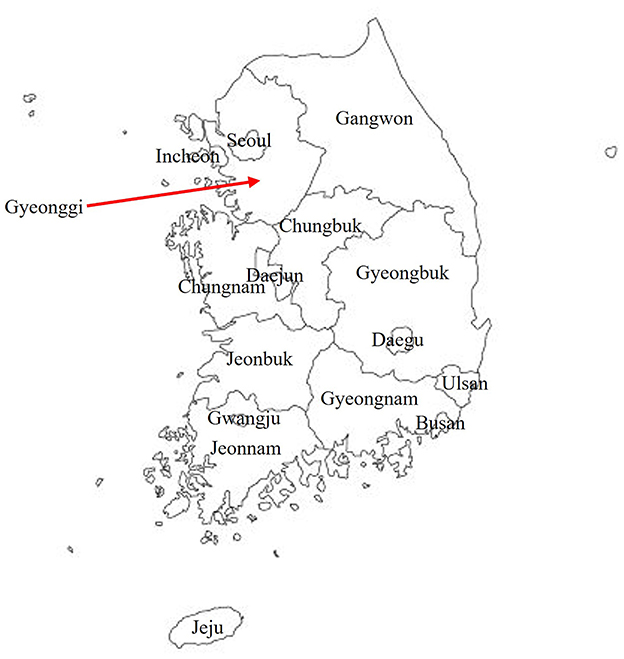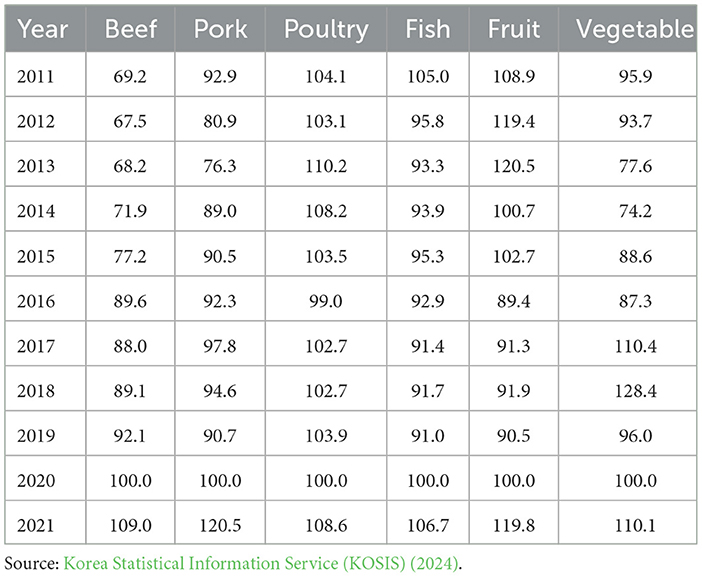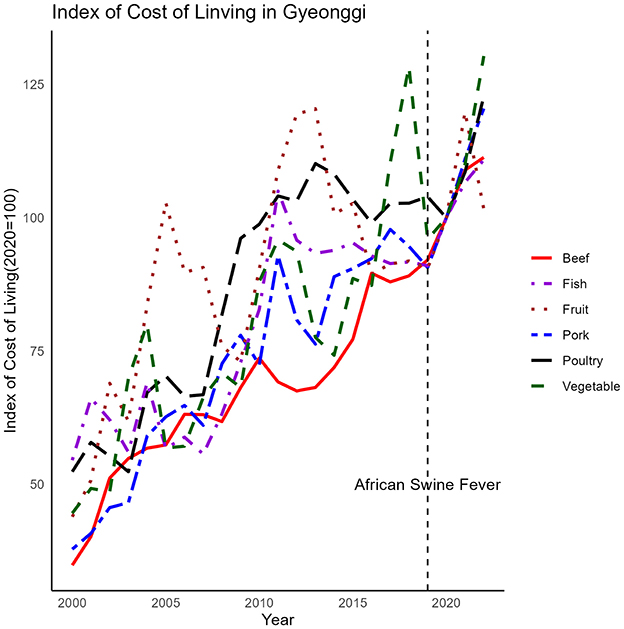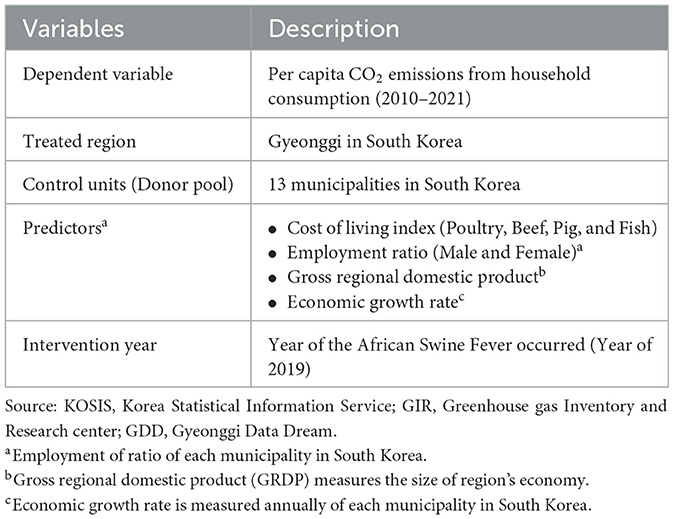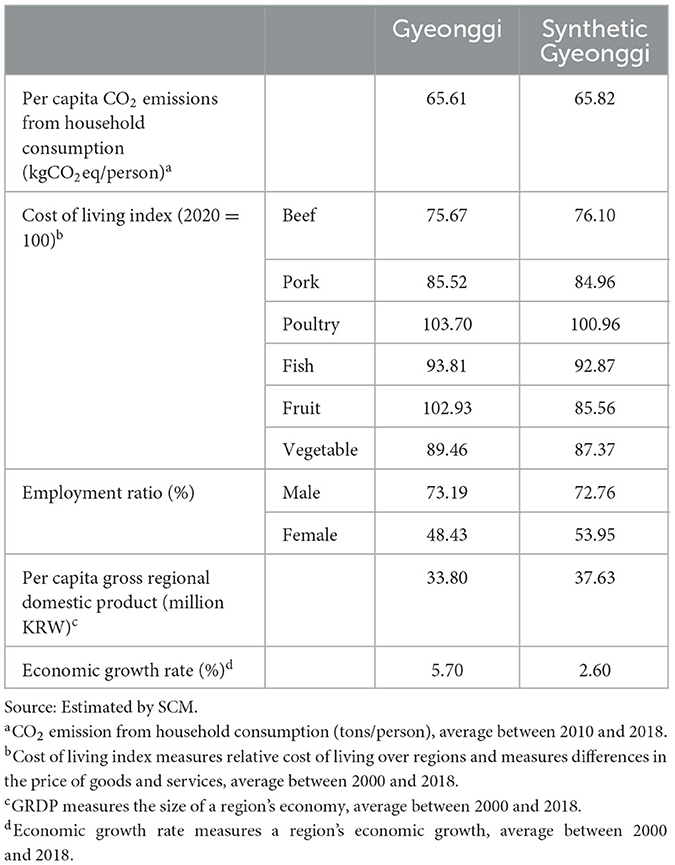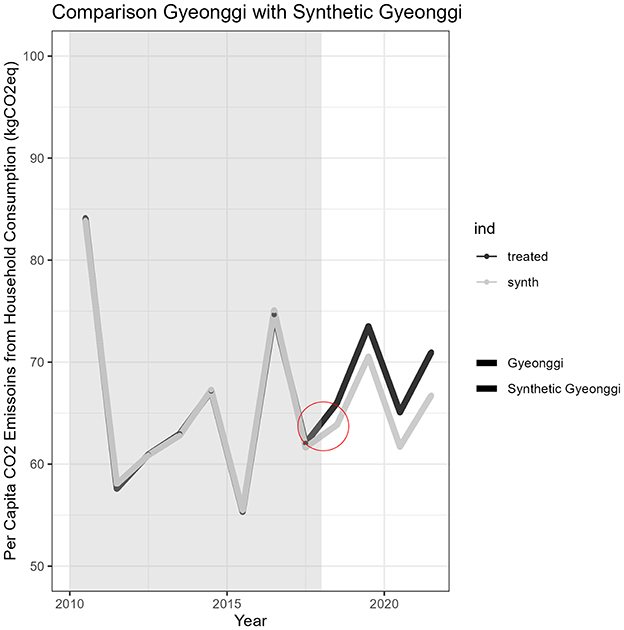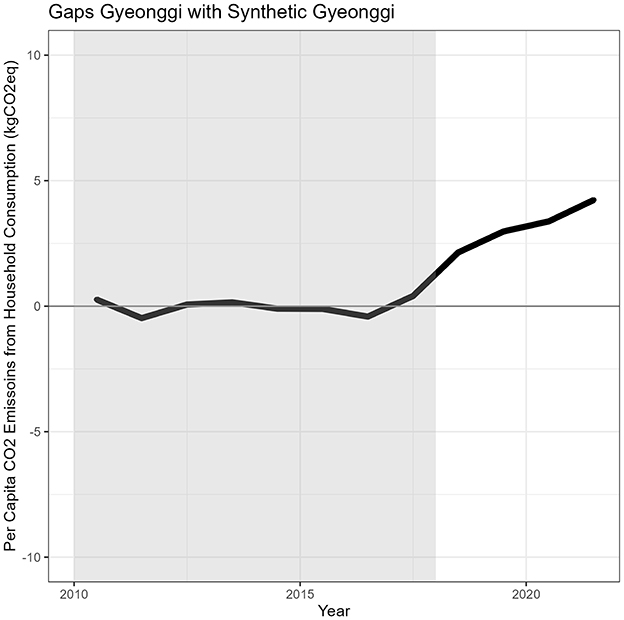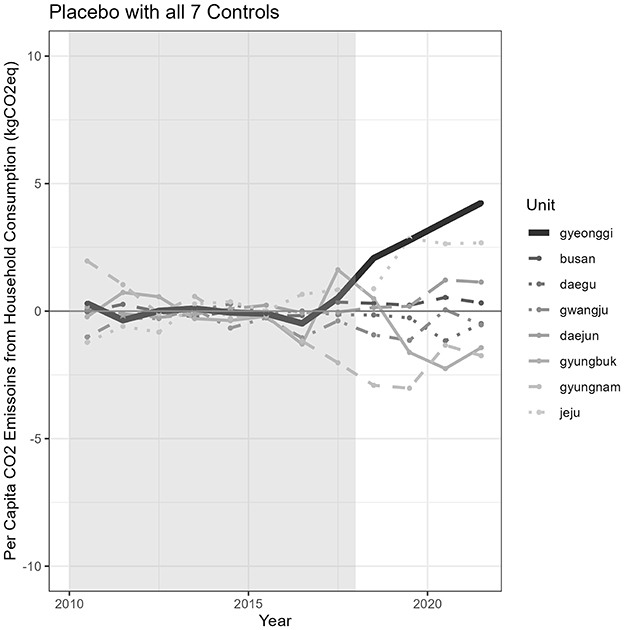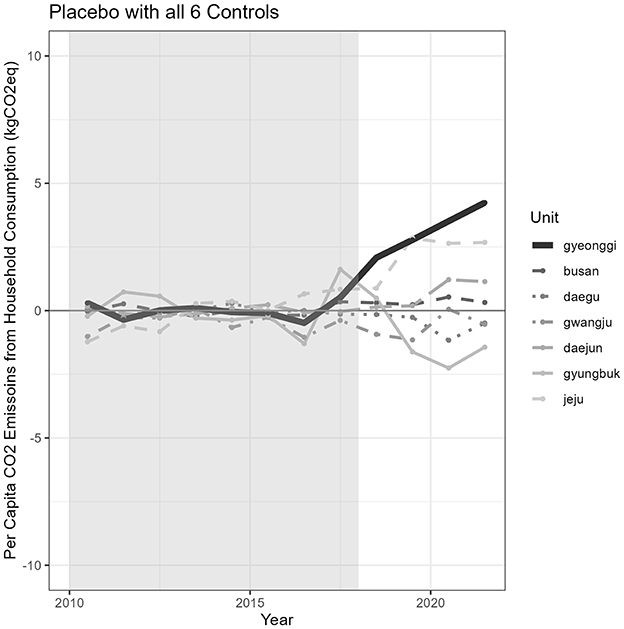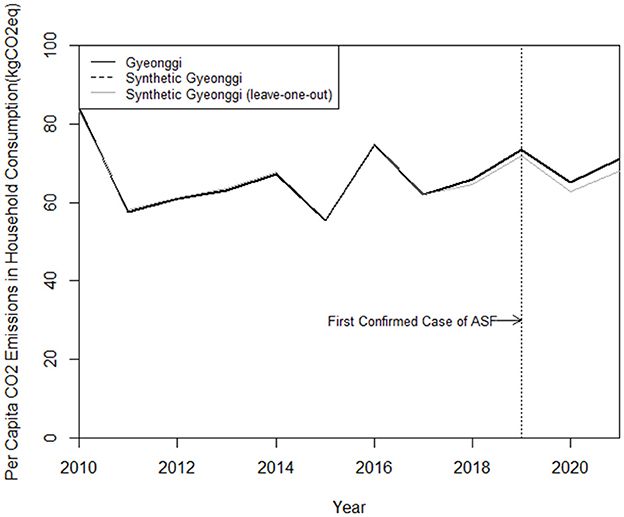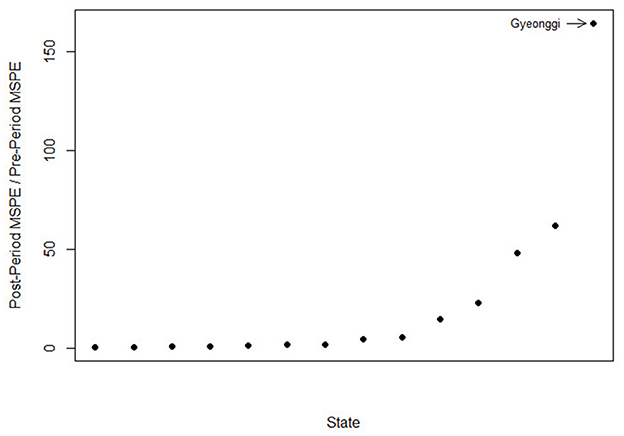- Research Fellow of Jeonbuk State Institute, Jeonju-si, Jeollabuk-do, Republic of Korea
African swine fever (ASF) occurred in Gyeonggi of South Korea in 2019 and there were 21 reported cases in domestic swine farms. South Korea is the one of top countries for pork consumption, and half of the 2.9 million tons of meat consumed in 2022 were pork. Outbreaks from animal products have a severe impact on the shift of diet and the change in dietary patterns of consumers shape climate change. Moreover, animal products account for 18% of worldwide GHG emissions which is more than industry (16%), transportation (13.5%), and energy usage (13%). This study is the first study to analyze the regional impact of animal products associated with climate change in South Korea. The objective of this study is to analyze the regional effect of dietary shifts on per capita CO2 emissions from household consumption in South Korea. Synthetic Control Method (SCM) is employed to analyze the impact of ASF on the change of per capita CO2 emissions from household consumption by shifting the nutritional patterns in South Korea. The dependent variable is per capita CO2 emissions from household consumption, and the type of event is an epizootic disease. The event period is between 2010 and 2021 (pre-intervention: 2010–2018 and post-intervention: 2019–2021). By establishing synthetic Gyeonggi from the optimal synthetic control unit, the trajectories present how dietary shifts have influenced per capita CO2 emissions from household consumption in a positive direction after ASF. ASF caused consumer dietary shifts from pork to other types of meat. This divergence between Gyeonggi and synthetic Gyeonggi indicates that there is an impact influencing per capita CO2 emissions from household consumption after ASF. Performing an SCM analysis with the treated (Gyeonggi) and control (thirteen municipalities) units, the study found that the two trajectory lines (Gyeonggi and synthetic Gyeonggi) were similar before diverging after the introduction of ASF. The gaps also indicate the impact of the shift in dietary patterns on per capita CO2 emissions from household consumption.
JEL classification: C31, Q54.
1 Introduction
Pork is the most-consumed meat in the world, and it has an expanding and highly competitive global market (USDA, 2023).1 South Korea is among the top countries for pork consumption; in 2022, around 2.9 million tons of meat were consumed, and half of that meat was pork [Korea Meat Trade Association (KMTA), 2024]. Pork consumption in South Korea has rapidly grown since the early 2000s, and the demand for pork is still highly imbalanced due to Korean consumers' unique preferences for specific cuts of meat (Shi, 2021). Consumers in South Korea have a unique consumption pattern and a strong preference for high-fat cuts such as belly and Boston butt (Choe et al., 2015). Table 1 indicates that in 2019, per capita beef and poultry consumption increased by 7.6% and 6.6%, respectively, while per capita pork consumption decreased by 1.2%. Per capita pork consumption is increasing by an annual average of 2.4%.
High feed and energy costs restrict South Korea's domestic pork production, so the total swine supply is expected to decline due to high production costs. Compound feed prices during the first 11 months of 2022 increased by 22% over the same period in 2021 (Ban, 2023). In agriculture, overuse of resources has increased greenhouse gas (GHG) emissions, causing serious environmental consequences such as climate change, and global warming. Animal products, such as red meat, dairy, and eggs, account for 18% of worldwide GHG emissions, more than industry (16%), transportation (13.5%), and energy usage (13%) (Jeong et al., 2023). Considering that over one-third of GHG emissions originate from the food system, livestock meat production plays a large part in the industry (Sugimoto et al., 2020; Liu et al., 2023). Growing demand for meat products causes the release of more GHG emissions into the atmosphere.2
Rogissart et al. (2019) found that the dietary patterns of consumers shape climate change. Nutritional patterns normally comprise 10%−30% of CO2 emissions from households, and animal-based products have a larger impact on GHG emissions than plant-based products (Center for Sustainable Systems, University of Michigan, 2022; Afrouzi et al., 2023). In 2019, African swine fever (ASF)3 occurred in Gyeonggi of South Korea in Figure 1; there were twenty-one reported cases in domestic swine farms and over 2,600 cases in wild boar (Cho et al., 2022). Loss of livestock, decreased market value, food insecurity, environmental impacts, and efforts to respond to animal diseases come at considerable costs to livelihoods and both public and private sector interests (Weaver and Habib, 2020).
The presence of ASF in China and Southeast Asia indicates the importance of animal diseases to economics, and epizootic diseases highlight the associated economic and human costs and the potential costs of other animal disease outbreaks in the future. Table 2 indicates the cost of living4 of consumer goods in Gyeonggi, South Korea. In 2019, the indexes of beef and poultry increased by 3.4% and 1.2%, respectively, while pork decreased by 4.1% after the outbreak of ASF in Figure 2.
This study is limited to an analysis of dietary patterns for various foods, making regional data collection difficult. However, this paper is the first study to analyze the regional impact associated with climate change in South Korea. The objective of this study is to analyze the regional effect of dietary shifts on per capita CO2 emissions from household consumption in South Korea. By applying the synthetic control method (SCM), this study shows how ASF has affected dietary changes, causing an increase in per capita CO2 emissions. The food industry causes GHG emissions, and shifts in dietary practices influence the environment and human health (Aleksandrowicz et al., 2016).
2 Method and data
This study applies the Synthetic Control Method (SCM)5 to analyze the impact of ASF on the change of per capita CO2 emissions from household consumption by shifting the nutritional patterns in South Korea. SCM is a particularly useful analysis tool for case studies with relatively small sample data in comparison to other methods. Constructing the donor pool is a critical step for getting an acceptable estimate and two outcomes derive from SCM. The synthetic control unit relies on the analogous factors between the predictor's estimates of the exposed and unexposed units (Bouttell et al., 2018). The weighted average of the control unit from the SCM is needed to make it feasible and similar to the treated unit (Abadie et al., 2010).
Assume that observable units i = 1, …, J and time t = 1, …, T0, T0+ 1, …, T, without the loss of generality, the treated (exposed to the event) unit is i = 1, and the control units (unexposed to the event) are i = 2, …, J; the pre-event period is t = 1, …, T0, and the post-event period is t = T0+ 1, …, T (Abadie et al., 2010). Let be the outcome with no event, and be the outcome with an event at time t and unit i.6 Dit be an indicator that indicates the value 1 if unit i experienced the event at time t and the value 0 otherwise; the impact of the event is assessed by the subtraction from in Equation 1 that is, in the post-event period in Equation 2.
The optimal synthetic control unit is constructed from four vectors (X0, X1, Z0, and Z1) with two weights (W and V). The X0 and Z0 indicate the predictor's and outcome's values of the control unit, and X1 and Z1 indicate the predictor's and outcome's values of the treated unit. Then, two weights W present the minimized distance between the predictors and each control unit's weight in Equation 3, and V present the minimized distance between the outcomes of treated and control unit in the pre-event period in Equation 4. From a minimized MSPE7 of the outcomes of treated/control units, the outer optimization is derived. The optimization provides asymptotically unbiased estimates of the treated unit (Abadie et al., 2010). Therefore, the optimal weight () is estimated from four vectors showing the impact of the event in Equation 5.
In this study, the dependent variable is per capita CO2 emissions from household consumption, and the type of event is an epizootic disease. The event period is between 2010 and 2021 (pre-intervention: 2010–2018 and post-intervention: 2019–2021).
The treated unit, Gyeonggi, and the selected 13 municipalities in South Korea which are not exposed to ASF in 2019 are included. The predictors from 14 municipalities are employment ratio, gross regional domestic product (GRDP) per capita, economic growth rate, and cost of living index (beef, pork, poultry, and fish) in Table 3.
3 Result
This study describes the per capita CO2 emissions from household consumption as a dependent variable, and ten independent variables are taken to create the synthetic control unit. The estimates of predictors in the pre-intervention period are presented in Table 4, which shows the similarity between Gyeonggi and synthetic Gyeonggi.8
In Table 5, the weights/regression weights of every municipality for creating the synthetic control unit are stated.9 The numbers in parentheses indicate the optimum synthetic unit for construction, such as Jeju (36.1%), Seoul (34.1%), Gyungbuk (22.0%), and Ulsan (5.5%). This implies that the mix of weighted municipalities provides the optimal synthetic control unit in the pre-event period. The regression weights of the unexposed units also deliver a synthetic control unit.10
By establishing synthetic Gyeonggi from the optimal synthetic control unit, Figures 3, 4 present how dietary shifts have influenced per capita CO2 emissions from household consumption in a positive direction after ASF. Figure 3 presents the comparison of per capita CO2 emissions between Gyeonggi and synthetic Gyeonggi between 2010 and 2021.
That trajectory of per capita CO2 emissions of synthetic Gyeonggi closely follows Gyeonggi's per capita CO2 emissions in the pre-intervention period. However, in 2019, the per capita CO2 emissions of Gyeonggi and synthetic Gyeonggi diverged in different directions. ASF caused consumer dietary shifts from pork to other types of meat. This divergence between Gyeonggi and synthetic Gyeonggi clearly indicates that there is an impact influencing per capita CO2 emissions from household consumption after ASF. Figure 4 presents the gaps in the per capita CO2 emissions between Gyeonggi and synthetic Gyeonggi. While the difference in the pre-intervention period is within ±1%, a divergence emerged after the introduction of ASF.
Placebo studies were performed by applying the SCM to support the statistical significance of ASF. The significance of the event is not established if there are gaps indicating a distinct magnitude between the tested and synthetic tested units (Abadie and Gardeazabal, 2003). For all thirteen municipalities in the control unit, placebo tests were conducted (Figures 5–7). For per capita CO2 emissions, the study presents a good fit, and other studies present the worst fit if it brings out the distant MSPE. Figure 6 presents the placebo studies, excluding municipalities showing an MSPE 20 times higher than that of the exposed unit (Gyeonggi). Six municipalities, including Seoul, are excluded, and there are still considerable deviations from zero. Figure 7 presents the exclusion of municipalities with 10 times higher MSPE, and one municipality was discarded. After exclusion through placebo studies (Figures 6, 7), there were six unaffected units left. Thus, this study finds that the random permutation possibility of the event is 1/6 = 0.166, representing an 84% statistical significance for the study.11
The leave-one-out in Figure 8 was performed next to estimate the sensitivity of the results, and the test was applied to give positive weights to the municipalities. The analysis used an optimal W* to minimize the distance between Gyeonggi and synthetic Gyeonggi in the pre-event span (Abadie et al., 2012). The gray lines of synthetic Gyeonggi with one of the six municipalities left out are recreated, and they are close to one another. The gaps between actual Gyeonggi and the six gray lines indicate that the study is robust to the exclusion of any particular municipality (Gong and Rao, 2016). The ratio of the post- to pre-event span MSPE of all 14 municipalities (one treated and 13 control units) is presented in Figure 9.
The MSPE ratio of Gyeonggi stands out, and the post-ASF MSPE is 164.53 times that of the pre-ASF MSPE. The second-highest MSPE ratio is 61.74 in Daejun, indicating that the ratio of Gyeonggi is 266% larger than that of the Daejun. The probability of having such a large ratio as Gyeonggi is 1/13 = 0.076 (7.6%) when any municipality randomly experiences ASF. Table 6 provides the ratio of post- to pre-ASF MSPE and RMSPE (root mean squared prediction error).12 Empirically, by estimating MSPE/RMSPE, the study can assess goodness of fit. MSPE/RMSPE ratios showing the highest values indicate an impact from ASF. The two exhibitive ratios of Gyeonggi are far from the rest of the municipalities. Therefore, there is a substantial event influencing the per capita CO2 emissions from household consumption.
4 Conclusion and discussion
Dietary practices can be affected by various factors such as socioeconomic status, demographics, culture, and lifestyle (Czarnocinska et al., 2020; Hassan et al., 2020), and the health of dietary patterns are linked to environmental sustainability (Grosso et al., 2020). Animal-based foods require higher energy use and cause more GHG emissions than plant-based foods (Scarborough et al., 2014). This is what motivated this study to determine the relationship between per capita CO2 emissions and shifts in dietary patterns. In 2019, the swine farms in Gyeonggi in South Korea lost economic animals and consumers had to alter their dietary patterns. When an epizootic disease occurs in a country, the industries related to production and consumption are influenced by the event. Therefore, this study analyzed changes in dietary patterns after the ASF outbreak in South Korea, influencing the per capita CO2 emissions from household consumption.
To analyze the relationship between dietary patterns and per capita CO2 emissions, the synthetic control method (SCM) is employed. In particular, the analysis focused on regional municipalities that provide little data. The SCM is widely used to estimate the impact of an event such as terrorism, political action, economic development plan, and natural disasters. There are studies (Aleksandrowicz et al., 2016; Geibel and Freund, 2023) analyzing the changes in dietary patterns and their impact on the emissions of greenhouse gas emissions, but they focus on the production side. However, this study concentrates on the consumption side, and how the consumers react to an external event such as an epizootic disease.
By performing an SCM analysis with the treated (Gyeonggi) and control (13 municipalities) units, the study found that the two trajectory lines (Gyeonggi and synthetic Gyeonggi) were similar before diverging after the introduction of ASF. The gaps also indicate the impact of the shift in dietary patterns on per capita CO2 emissions from household consumption. These two decisive figures indicate the effects of an epizootic disease, and the critical point of applying the SCM is to establish a synthetic control unit. How the Gyeonggi and synthetic Gyeonggi are similar is provided in the previous section such as per capita CO2 emissions, cost of living indices, and economic factors.
The SCM is an effective method for analyzing limited samples, but it causes statistical problems for sensitivity and robustness. Therefore, the critical part of performing the analysis is selecting predictors that indicate the similarities between the treated and control units. Placebo studies, a post- to pre-MSPE ratio, and a leave-one-out were performed to support the statistical inferences. The figures present evidence that the trajectory divergences result from shifts in consumer dietary patterns. This study is the first to analyze at the level of municipalities, presenting the relationship between dietary pattern shifts and per capita CO2 emissions from household consumption after ASF.
The relationship between the shifts in dietary patterns and per capita CO2 emissions is proven through the evidence supporting the statistical inferences. However, the collection of predictors of municipalities in South Korea for analysis was limited. Climate change is one of the biggest concerns this planet has, and it affects the living. Upon analyzing the relationship between the change in dietary patterns and per capita CO2 emissions, the outcomes of this study are meaningful. When an unexpected epizootic disease occurs in a country, the authority tries to recover the losses of farms and stabilize a disequilibrium in consumption. By building a synthetic control unit, policymakers, farmers, and even consumers can expect how much an epizootic disease causes damage.
Data availability statement
The datasets presented in this study can be found in online repositories. The names of the repository/repositories and accession number(s) can be found below: Korean Statistical Information Service.
Author contributions
SE: Writing – original draft, Writing – review & editing.
Funding
The author(s) declare that no financial support was received for the research, authorship, and/or publication of this article.
Conflict of interest
The author declares that the research was conducted in the absence of any commercial or financial relationships that could be construed as a potential conflict of interest.
Publisher's note
All claims expressed in this article are solely those of the authors and do not necessarily represent those of their affiliated organizations, or those of the publisher, the editors and the reviewers. Any product that may be evaluated in this article, or claim that may be made by its manufacturer, is not guaranteed or endorsed by the publisher.
Footnotes
1. ^Pork is the most widely eaten meat in the world (36%) followed by poultry (33%), beef (24%), and goat (5%) (USDA, 2023).
2. ^Each kilogram of beef product produces 99.48 kgCO2eq, while poultry and pig products produce 9.87 and 12.31 kgCO2eq, respectively STATISTA (2024).
3. ^ASF is a highly contagious disease in domestic pigs [World Organization for Animal Health (WOAH), 2023], and it causes tremendous socioeconomic damage.
4. ^Cost of living is calculated periodically in nearly representative baskets of consumer goods.
5. ^The Synthetic Control Method (SCM) has been employed to estimate the impact of an intervention on various research interests: terrorism (Abadie and Gardeazabal, 2003), political action (Bohn et al., 2014), local construction (Ando, 2015), and disasters (Wang et al., 2013).
6. ^The superscript N above Y indicates the outcome is not exposed to the event, and the superscript I above Y indicates the outcome is exposed to the event.
7. ^MSPE stands for mean squared prediction error that presents the difference between the fitted and the true value.
8. ^There are variables indicating a not-quite resemblance between Gyeonggi and synthetic Gyeonggi. This is because Gyeonggi's consumption is moderate relative to the regions in the control unit, which means there is no linear combination of regions that implies that synthetic Gyeonggi is not perfectly reproduced (Chelwa et al., 2015).
9. ^The results are from R, and the codes are modified by Becker et al. (2016).
10. ^The regression weights are not restricted to lie between zero and one, allowing extrapolation. The synthetic control method makes explicit the contribution of each comparison unit to the counterfactual of interest (Abadie et al., 2012).
11. ^The statistical inference presents the statistical significance of the proximity of the synthetic control unit to the treated unit. After excluding ten times higher MSPE than Gyeonggi, Figure 8 provides six unaffected units. The proximity of the synthetic control unit to the treated unit has a probability of 1/6 (0.166) and shows 84% significance of proximity.
12. ^RMSPE is the rooted value of MEPE.
References
Abadie, A., Diamond, A., and Hainmueller, J. (2010). Synthetic control methods for comparative case studies: estimating the effect of California's tobacco control program. J. Am. Stat. Assoc. 105, 493–505. doi: 10.1198/jasa.2009.ap08746
Abadie, A., Diamond, A., and Hainmueller, J. (2012). Synth: an R package for synthetic control methods in comparative case studies. J. Stat. Softw. 42. 1–17. doi: 10.18637/jss.v042.i13
Abadie, A., and Gardeazabal, J. (2003). The economic costs of conflict: a case study of the Basque country. Am. Econ. Rev. 93, 113–132. doi: 10.1257/000282803321455188
Afrouzi, H. N., Ahmed, J., Siddique, B. M., Khairuddin, N., and Hassan, A. (2023). A comprehensive review on carbon footprint of regular diet and ways to improving lowered emissions. Results Eng. 18:101054. doi: 10.1016/j.rineng.2023.101054
Aleksandrowicz, L., Green, R., Joy, E. J., Smith, P., and Haines, A. (2016). The impacts of dietary change on greenhouse gas emissions, land use, water use, and health: a systematic review. PLoS ONE 11:e0165797. doi: 10.1371/journal.pone.0165797
Ando, M. (2015). Dreams of urbanization: Quantitative case studies on the local impacts of nuclear power facilities using the synthetic control method. J. Urban Econ. 85, 68–85. doi: 10.1016/j.jue.2014.10.005
Ban, Y. K. (2023). Livestock and Product Semi-annual (South Korea). USDA Foreign Agricultural Service.
Becker, M., Klößner, S., and Pfeifer, G. (2016). Cross-Validating Synthetic Controls. MPRA Paper No. 83679.
Bohn, S., Lofstrom, M., and Raphael, S. (2014). Did the 2007 legal Arizona workers act reduce the state's unauthorized immigrant population? Rev. Econ. Stat. 96, 258–269. doi: 10.1162/REST_a_00429
Bouttell, J., Craig, P., Lewsey, J., Robinson, M., and Popham, F. (2018). Synthetic control methodology as a tool for evaluating population-level health interventions. J. Epidemiol. Commun. Health 72, 673–678. doi: 10.1136/jech-2017-210106
Center for Sustainable Systems University of Michigan. (2022). Carbon Footprint Factsheet. Pub. No. CSS09-05.
Chelwa, G., Walbeek, C., and Blecher, E. (2015). “Evaluating South Africa's tobacco control initative: a synthetic control approach,” in ERSA Working Paper: Economic Research Southern Africa.
Cho, K. H., Hong, S. K., Jang, M. K., Ryu, J. H., Kim, H. J., Lee, Y. R., et al. (2022). Comparison of the virulence of Korean African swine fever isolates from pig farms during 2019–2021. Viruses 14:2512. doi: 10.3390/v14112512
Choe, J. H., Yang, H. S., Lee, S. H., and Go, G. W. (2015). Characteristics of pork belly consumption in South Korea and their health implication. J. Animal Sci. Technol. 57, 1–7. doi: 10.1186/s40781-015-0057-1
Czarnocinska, J., Wadolowska, L., Lonnie, M., Kowalkowska, J., Jezewska-Zychowicz, M., and Babicz-Zielinska, E. (2020). Regional and socioeconomic variations in dietary patterns in a representative sample of young polish females: a cross-sectional study (GEBaHealth project). Nutr. J. 19:26. doi: 10.1186/s12937-020-00546-8
Food and Agriculture Organization of the United Nations (2023). Food Balance. Available at: https://www.fao.org/faostat/en/#data/FBS
Geibel, I., and Freund, F. (2023). The effects of dietary changes in Europe on greenhouse gas emissions and agricultural incomes in Ireland and Denmark. Environ. Res. Lett. 18:124026. doi: 10.1088/1748-9326/ad0681
Gong, X., and Rao, M. (2016). The economic impact of prolonged political instability: a case study of Fiji. Policy Stud. 37, 370–386. doi: 10.1080/01442872.2016.1157856
Grosso, G., Fresán, U., Bes-Rastrollo, M., Marventano, S., and Galvano, F. (2020). Environmental impact of dietary choices: role of the Mediterranean and other dietary patterns in an Italian cohort. Int. J. Environ. Res. Public Health 17:1468. doi: 10.3390/ijerph17051468
Hassan, F., Kalsoom, S., Sheikh, N. H., and Humayun, A. (2020). Factors affecting food consumption patterns and dietary practices of adolescent girls: an explanatory sequential mixed method study. Ann. King Edward Med. Univ. 26, 9–18. doi: 10.21649/akemu.v26i1
Jeong, D., Kim, Y. S., Cho, S., and Hwang, I. (2023). A case study of CO2 emissions from beef and pork production in South Korea. J. Animal Sci. Technol. 65:427. doi: 10.5187/jast.2022.e109
Korea Meat Trade Association (KMTA) (2024). Meat Consumption. Available at: http://www.kmta.or.kr/kr/data/stats_spend.php
Korea Statistical Information Service (KOSIS) (2024). Available at: https://kosis.kr/index/index.do
Liu, T. C., Wu, Y. C., and Chau, C. F. (2023). An overview of carbon emission mitigation in the food industry: efforts, challenges, and opportunities. Processes 11:1993. doi: 10.3390/pr11071993
Rogissart, L., Foucherot, C., and Bellassen, V. (2019). Estimating greenhouse gas emissions from food consumption: methods and results. Doctoral dissertation, Inconnu.
Scarborough, P., Appleby, P. N., Mizdrak, A., Briggs, A. D., Travis, R. C., Bradbury, K. E., et al. (2014). Dietary greenhouse gas emissions of meat-eaters, fish-eaters, vegetarians and vegans in the UK. Clim. Change 125, 179–192. doi: 10.1007/s10584-014-1169-1
Shi, P. (2021). Source Differentiated Pork Import Demand for South Korea: Implications to Canadian Exports. University of Alberta.
STATISTA (2024). Average Greenhouse Gas Emissions Per Kilograms of Major Food Products Worldwide. Available at: https://www.statista.com/statistics/1201677/greenhouse-gas-emissions-of-major-food-products/#:~:text=Food%20emissions%20vary%20greatly%20depending,les%20than%2010%20kg%20CO2eq
Sugimoto, M., Murakami, K., Fujiwara, A., Asakura, K., Masayasu, S., and Sasaki, S. (2020). Association between diet-related greenhouse gas emissions and nutrient intake adequacy among Japanese adults. PLoS ONE 15:e0240803. doi: 10.1371/journal.pone.0240803
USDA (2023). Livestock, Dairy, and Poultry Outlook: October 2023. Economic Research Service. LDP-M-352.
Wang, Y. -D., Byrne, J., Kurdgelashvili, L., Brehm, C., Saul, K. M., Kramer, G., et al. (2013). International Energy Policy in the Aftermath of the Fukushima Nuclear Disaster: An Analysis of Energy Policies of the U.S., U.K., Germany, France, Japan, China and Korea. Center for Energy and Environment Policy; University of Delaware.
Weaver, T. R. D., and Habib, N. (2020). Evaluating losses associated with African swine fever in the People's Republic of China and Neighboring Countries. ADB East Asia Working Paper Series. No. 27. doi: 10.22617/WPS200263-2
World Organization for Animal Health (WOAH) (2023). Available at: https://www.woah.org/en/home/
Keywords: African swine fever, meat consumption per capita, per capita CO2 emissions, change of dietary patterns, synthetic control method (SCM)
Citation: Eun S (2024) Change of dietary patterns on CO2 emissions under the African swine fever in South Korea. Front. Clim. 6:1485355. doi: 10.3389/fclim.2024.1485355
Received: 23 August 2024; Accepted: 06 December 2024;
Published: 20 December 2024.
Edited by:
Carlotta Giromini, University of Milan, ItalyReviewed by:
John Malcolm Gowdy, Rensselaer Polytechnic Institute, United StatesKiriaki M. Keramitsoglou, Democritus University of Thrace, Greece
Copyright © 2024 Eun. This is an open-access article distributed under the terms of the Creative Commons Attribution License (CC BY). The use, distribution or reproduction in other forums is permitted, provided the original author(s) and the copyright owner(s) are credited and that the original publication in this journal is cited, in accordance with accepted academic practice. No use, distribution or reproduction is permitted which does not comply with these terms.
*Correspondence: Sungtae Eun, c3RldW45OUBnbWFpbC5jb20=
 Sungtae Eun
Sungtae Eun
